The Bishop from Kumla
3D-model of a bishop's head in the collections of the Swedish History Museum (CC BY 4.0).
This head is part of a sculpture of a holy bishop. The sculpture is made of limewood, with traces of green polychromy, or paint, on the mitre, or headpiece. The bishop’s head probably belongs to a headless sculpture from Kumla Church, which is now kept at the Västmanland Museum. It was likely made in the late 1400s.

Sculpture of bishop's head
The original object that was 3D-scanned.
Digitisation in 3D
The Swedish History Museum is part of the government agency National Historical Museums. The organisation is constantly working to digitise its collections. One example of this work is the creation of 3D models of some of the museum’s objects.
How is a 3D model made?
A photographer takes a large number of still photos of an object from different angles. These images are then processed by computer software to create a digital version of the object – a 3D model. This technique is called photogrammetry or Structure from Motion (SfM).
In this way, 3D models of objects from the museum’s collections are continuously being created. The models are made available on the platform Sketchfab.com, where you can view, download and freely reuse them under an open licence. Have you used our 3D models to create something you’d like to share with us? Or would you like to get in touch with the department responsible for the 3D models? Feel free to email: bilder@shm.se




